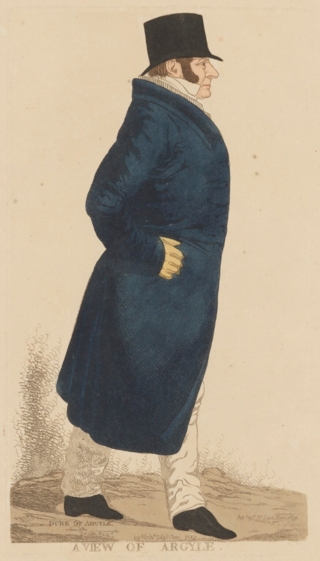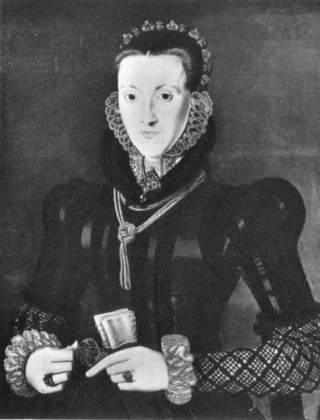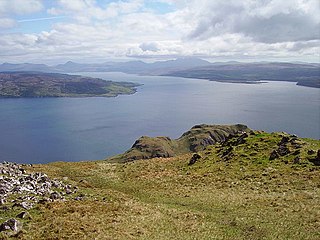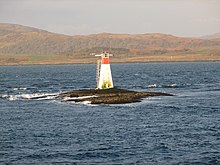
Clan Campbell is a Highland Scottish clan, historically one of the largest and most powerful of the Highland clans. The Clan Campbell lands are in Argyll and within their lands lies Ben Cruachan. The chief of the clan became Earl of Argyll and later Duke of Argyll.

Duke of Argyll is a title created in the peerage of Scotland in 1701 and in the peerage of the United Kingdom in 1892. The earls, marquesses, and dukes of Argyll were for several centuries among the most powerful noble families in Scotland. As such, they played a major role in Scottish history throughout the 16th, 17th, and 18th centuries. The Duke of Argyll also holds the hereditary titles of chief of Clan Campbell and Master of the Household of Scotland.

Archibald Campbell, Marquess of Argyll, 8th Earl of Argyll, Chief of Clan Campbell was a Scottish nobleman, politician, and peer. The de facto head of Scotland's government during most of the conflict of the 1640s and 50s known as the Wars of the Three Kingdoms, he was a major figure in the Covenanter movement that fought for the maintenance of the Presbyterian religion against the Stuart monarchy's attempts to impose episcopacy. He is often remembered as the principal opponent of the royalist general James Graham, 1st Marquess of Montrose.

Argyll, sometimes called Argyllshire, is a historic county and registration county of western Scotland.
Gillespie Archibald Campbell, 2nd Earl of Argyll was a Scottish nobleman and politician who was killed at the Battle of Flodden.
Colin Campbell, 3rd Earl of Argyll was a Scottish nobleman and soldier. He was also known as "Cailen Malloch".
Archibald Campbell, 4th Earl of Argyll or Archibald "the Red" Campbell, was a Scottish nobleman and politician.
Colin Campbell, 6th Earl of Argyll was a Scottish nobleman and politician. He was appointed to the Lord Chancellorship of Scotland.

Duart Castle, or Caisteal Dhubhairt in Scottish Gaelic, is a castle on the Isle of Mull, beside the Sound of Mull off the west coast of Scotland, within the council area of Argyll and Bute. The castle dates back to the 13th century and is the seat of Clan MacLean. One source states that the castle was "brought back from ruin in 1911".

Clan MacLean is a Highlands Scottish clan. They are one of the oldest clans in the Highlands and owned large tracts of land in Argyll as well as the Inner Hebrides. Many early MacLeans became famous for their honour, strength and courage in battle. They were involved in clan skirmishes with the Mackinnons, Camerons, MacDonalds and Campbells, as well as all of the Jacobite risings.

George William Campbell, 6th Duke of Argyll,, styled Earl of Campbell from 1768 to 1770 and Marquess of Lorne from 1770 to 1806, was a Scottish Whig politician and nobleman.

The Battle of Glenlivet was a Scottish clan battle fought on 3 October 1594 near Glenlivet, Moray, Scotland. It was fought between Protestant forces loyal to King James VI of Scotland who were commanded by Archibald Campbell, 7th Earl of Argyll, against Catholic forces who were commanded by George Gordon, 6th Earl of Huntly, and Francis Hay, 9th Earl of Erroll. The Catholics won a decisive victory in the battle, but in the aftermath were subdued by King James.

Ian Campbell, 12th Duke of Argyll,, styled Marquess of Lorne between 1949 and 1973, was a Scottish peer and Chief of Clan Campbell. He was the 12th Duke of Argyll in the Peerage of the United Kingdom and Lord Lieutenant of Argyll and Bute.

Carter-Campbell of Possil is a branch of Clan Campbell, a Scottish clan. Historically, they are part of Clan Campbell, which was regarded as one of the largest Scottish clans. The branch of the Campbell clan was historically centred in Lawers. Some of the clan, which originated with the original Campbells, had links to the lands of Argyll.

Sir John Maclean, 4th Baronet of Duart and Morvern (1670–1716) was the 20th Clan Chief of Clan Maclean from 1674 to 1716. He was the 16th and last Laird of Duart, when in 1691 he lost Castle Duart to Archibald Campbell, 1st Duke of Argyll. The castle wasn't recovered by Clan Maclean until 1912 until it was purchased by Fitzroy Donald Maclean, 221 years later.
Lachlan Catanach Maclean was the 11th Clan Chief of Clan MacLean from 1515 until his murder in 1523.

Eachann Mór Maclean (1497–1568) or Hector Mor Maclean, or Hector Maclean the Great, was the 12th Chief of Maclean. Mór or Mor translates as great when added to a name in Scottish Gaelic. He was the 8th laird of Duart Castle.

Agnes Keith, Countess of Moray was a Scottish noblewoman. She was the wife of James Stewart, 1st Earl of Moray, regent of Scotland and the illegitimate half-brother of Mary, Queen of Scots, making her a sister-in-law of the Scottish queen. As the wife of the regent, Agnes was the most powerful woman in Scotland from 1567 until her husband's assassination in 1570.

The Sound of Mull is a sound between the Inner Hebridean island of Mull and mainland Scotland. It forms part of the Atlantic Ocean.
Alexander Carragh MacDonnell, also spelt MacDonald, was the 5th lord of Dunnyveg, Scotland, alive c. 1480–1538.
















